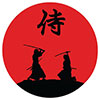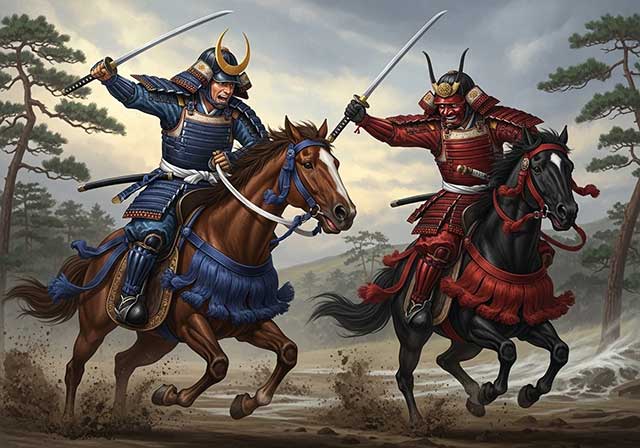
As early as the 8th century AD, Japanese emperors gradually lost their real power and became symbolic figures, under the complete control of the powerful Fujiwara clan. This clan, by marrying their daughters to emperors, effectively monopolized the government of the country: all key military and administrative positions were held by representatives of the Fujiwara.
Background to the conflict
The system of appointing officials based on family ties undermined the previous order, when the emperor personally approved the governors of the provinces. Gradually, power became concentrated in the hands of the governors: the official rulers lived in the capital Heian (modern-day Kyoto), indulging in refined entertainment, while the administration of their vast estates—shoen—was transferred to trusted individuals. Over time, these administrators began to feel like the actual owners of the land.
Wars with local tribes continued on the outskirts of the country, forcing the governors to maintain armed forces. While the Fujiwara clan was busy with palace intrigues, a new class of people with real military power, political influence, and economic resources quietly emerged in the country.
And very soon they made themselves known. In 935, Taira Masakado, dissatisfied with the fact that the Fujiwara clan had bypassed him in the appointment of the capital's police chief, raised a rebellion in the Kanto region and even proclaimed himself the new emperor — an unprecedented event that has never been repeated. For five years, he held the eastern part of the country under his control until he was defeated by his relative Taira no Sadamori. This rebellion was an alarming sign: the Fujiwara clan's power was under threat. They could only maintain control by using old methods — encouraging some military clans and setting them against others.
Military power in Japan at that time was concentrated in the hands of certain clans. In the 8th century, these were the Otomo, Saeki, and Sakanoe clans, and in the 9th century, the Ono and Okura clans. In the 10th century, two new influential clans came to the fore: the Taira (Heike in Chinese) and Minamoto (Genji) clans. The Taira established themselves in the southwestern lands, protecting the coast from pirates and waging war against the rebellious princes of Kyushu and Shikoku. The Minamoto traditionally controlled the northeast of Honshu Island, where they gained fame in their struggle against the Emishi tribes.
Although the two clans often united against external enemies and were linked by marriage, their rivalry gradually intensified. The Fujiwara clan also contributed to this, fearing the excessive rise of one clan, they invariably called on the forces of the other to oppose it. Thus, the feud between the Taira and Minamoto clans grew deeper.
By the end of the 11th century, the situation had changed: the emperors themselves, tired of the Fujiwara clan's guardianship, began to seek to regain their power. This gave rise to the practice of “monastic emperors” — the ruler officially abdicated in favor of a minor heir, formally dependent on the regents from the Fujiwara clan, but continued to secretly influence politics, remaining a real figure behind the scenes.
In 1156, the young Emperor Konoe died, and Gosirakawa (1127–1192), the son of the former Emperor Toba, ascended the throne. Another son of Toba, also a former emperor, Sutoku (Konoe's father), decided to seize the throne again and turned to the military for support. Gosirakawa did the same. Thus, the formal dispute over the succession to the throne turned into a clash between two Fujiwara factions, each backing its own candidate.
Both the Minamoto and Taira clans took part in the fighting in the streets of the capital on both sides of the conflict. The result was the siege of the palace, where Sutoku had fortified himself, and his defeat. Most of the Minamoto who fought on his side were executed. These events went down in history as the Hogen no Ran, or “the troubled times of the Hogen years.”
The winner was Taira Kiyomori (1118–1181), who became the emperor's closest advisor. Minamoto Yoshitomo (1123–1160), who also supported Gosirakawa, received far fewer rewards and harbored a grudge. He also hated Kiyomori for ordering the execution of his father, who had fought for Sutoku, and insisting that Yoshitomo personally kill all his relatives who had participated in the rebellion, including his young brothers. As a result, in 1160, Yoshitomo, with the support of Fujiwara no Nobuyori, raised a new rebellion.
They captured Emperor Go-Shirakawa (who was already former emperor at that point) and his son, who had been proclaimed the new ruler of Nijo, and took them to the Sanjo-den Palace on the outskirts of Kyoto. Kiyomori, who was away at the time, hurried back, gathered about a thousand soldiers, and surrounded the palace. The emperors were successfully taken away, disguised in women's clothing, after which the assault followed. These events went down in history as the Heiji Rebellion.
Nobuyori was wounded and executed, Yoshitomo tried to flee to the eastern lands, but was captured and killed in a bathhouse. Only a few of his clan survived, among them his son Minamoto no Yoritomo (1147–1199). Mass repression began in the country, and the Minamoto clan was almost completely destroyed. Kiyomori, having consolidated his power, transferred all important posts to his relatives, establishing a harsh dictatorship. At that time, people said, “In Japan now, if you are not from the Taira clan, you are not a person.”
The Rebellion of Prince Motohito
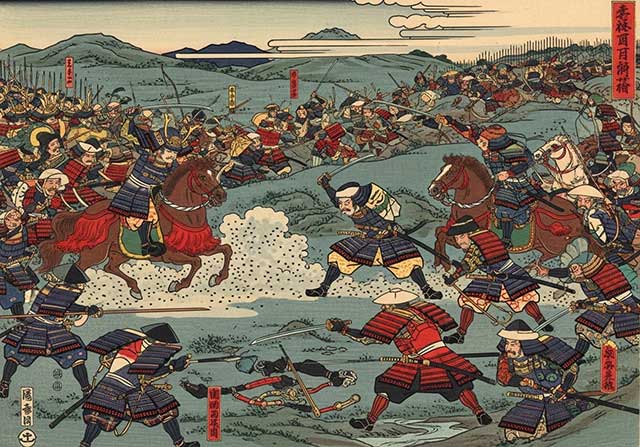
By 1180, Taira no Kiyomori had reached the height of his power. He controlled the entire country, his daughter had become empress, and his three-year-old grandson had been enthroned under the name Antoku. To emphasize the grandeur of this event, Kiyomori went on a pilgrimage with the boy to the ancestral temple of the Taira family.
It was at this time that Prince Motohito, who had already been passed over twice for the throne, secretly sent out a call to the eastern lands to the supporters of the Minamoto clan, urging them to punish the “bandits of the Taira clan.” However, the conspiracy was uncovered. The elderly Minamoto Yorimasa, the only member of his clan who remained at court, was sent against the prince. Paradoxically, Yorimasa himself was involved in the conspiracy.
With a small group of about fifty supporters, Motohito and Yorimasa took refuge in the Miidera monastery. They counted on the help of the warrior monks of the Enryaku-ji temple on Mount Hiei, but Kiyomori's men had already won them over to their side. Left without the expected support, the fugitives and a handful of followers (about three hundred people) moved to Uji on the southern bank of the Ujigawa River, hoping to find help there from the monks of the city of Nara.
Kiyomori, learning of the uprising, sent a large army against them. The Taira samurai approached the northern bank of the river. A fierce battle ensued. The monks dismantled the bridge deck, and the Taira cavalry, trying to force the crossing, fell into the gap, breaking their horses' legs. The samurai attacked the bridge several times, but each time they were repelled.
Finally, the young warrior Ashikaga Tadatsuna, along with three hundred horsemen, rushed into the river and managed to cross to the other side. The entire Taira army rushed after him. The battle flared up with renewed vigor. Realizing the hopelessness of the situation, Yorimasa committed seppuku, his sons died in battle, and Prince Motohito himself tried to escape but was caught and beheaded.
Thus, the rebellion ended before it had even begun: the attempt to raise the country against the Taira clan had failed.
Yoritomo

Despite the defeat of Prince Motohito's rebellion, there was a man in the eastern lands who was ready to lead the further struggle against Taira. He was Minamoto no Yoritomo (1147–1199), the eldest son of Yoshitomo, who had died two decades earlier.
After the defeat of his clan, Yoritomo lived in exile on the Izu Peninsula, under the supervision of the local ruler Hojo Tokimasa. There he married his daughter and managed to win his father-in-law over to his side. Gathering a hundred horsemen provided by Tokimasa, Yoritomo attempted to break out of Izu, which was surrounded by Taira supporters. However, his army was defeated at Mount Ishibashiyama by forces commanded by Oba Kagetika.
After the defeat, Yoritomo wandered alone for several days, risking capture at any moment. But he managed to reach the small village of Kamakura. It was there that samurai of the Minamoto clan from all over the Kanto region began to gather, turning Kamakura into the center of the future struggle.
Kiyomori, wanting to nip the rebellion in the bud, sent an army under the command of his beloved grandson Taira Koremori. He was known as a talented poet, but his military skills were weak. In the fall of 1180, about 15,000 Taira samurai marched across the Hakone Mountains and entered the Kanto region. But here they felt like strangers: Kanto was considered the ancestral home of the Minamoto clan. In addition, only a third of Koremori's army consisted of proven fighters, the rest were hastily gathered in the vicinity of the capital.
Reaching the Fuji River, Taira's army set up camp on its banks. On the opposite side, about 20,000 Minamoto warriors were stationed. On the night of November 9, panic broke out in the Taira camp: the noise of geese and ducks taking flight was mistaken for a signal to attack. Believing that they were surrounded by enemies, the warriors fled in panic, leaving their weapons and armor behind.
In the morning, the Minamoto discovered the empty camp and were amazed by their unexpected easy victory. Yoritomo did not pursue the fugitives: his goal was first and foremost to consolidate his power in the eastern provinces. This victory, without a single casualty, went down in history as the Battle of Fujikawa.
Yoshinaka
In the spring of 1181, Taira Kiyomori died. Before his death, he bequeathed that Yoritomo's head be placed on his grave. However, after him, Munemori became the head of the clan—a weak-willed and indecisive man who immediately had to face a difficult situation: the samurai of the islands of Kyushu and Shikoku rose up against Taira, and Minamoto no Yukiie, Yoritomo's uncle, was already heading for the capital with his own army.
But Yukie proved to be a poor military leader. On April 25, 1181, he launched an attack across the Sunomata River against a numerically superior enemy. The Taira pretended to retreat, then launched a coordinated attack on the soldiers, who were fighting in heavy, wet armor. Yukiie fled and found refuge in the province of Shinano with Kiso Yoshinaka, Yoritomo's nephew.
In the summer of that year and the following summer, the fighting almost ceased. The country was struck by crop failure and terrible famine, which hit the Taira lands particularly hard. The Kanto region suffered less, and thus the entire east was effectively under Yoritomo's control. However, it was not he who resumed hostilities first, but Kiso Yoshinaka.
By the winter of 1182, Yoshinaka had subjugated the province of Shinano and then conquered four more northern regions that separated him from the capital. But he did not face Taira's army, but his own uncle, Yoritomo. The latter, seemingly obsessed with suspicion, often sought to get rid of his relatives and rivals. Yoritomo even sent an army against Yoshinaka, but after brief negotiations, the two sides parted ways. Yoshinaka then continued his active operations, while Yoritomo preferred to wait and see.
In May 1183, a huge Taira army marched on Yoshinaka. The Heike Monogatari claims that it numbered up to 100,000 men, but most of them were untrained peasants, poorly armed and hastily assembled. The army was commanded by Koremori, who had been defeated at Fujikawa. The army's supplies were poorly organized, and even before the fighting began, people began to scatter.
Yoshinaka opposed them with half as many warriors, but they were battle-hardened samurai. On June 2, a battle took place in the Kurikata Valley. Yoshinaka lured the enemies onto a narrow ledge and attacked them from three sides at once, while on the fourth side he released a herd of enraged bulls with torches tied to their horns. The panic and defeat were complete. The Taira army, having lost a significant part of its men, hastily retreated to Kyoto.
Then Yoshinao, having joined forces with Yukie, continued his advance in the north and in August 1183 triumphantly entered the capital.
Ichi-no-tani
Yoshinaka's entry into Kyoto was initially greeted with jubilation: he was considered a liberator. However, the residents of the capital and the courtiers soon became disillusioned. The warriors from the northern provinces behaved brutally, plundering wealthy estates and killing civilians. Emperor Go-Shirakawa secretly turned to Yoritomo for help.
Yoritomo sent 60,000 warriors to the capital under the command of his brothers Noriyori and Yoshitsune. In a series of battles at Uji and Seta, on the southern and eastern approaches to Kyoto, they defeated Yoshinaka's forces and entered the city. Yoshinaka himself was killed by an accidental arrow in February 1184.
Meanwhile, the Taira clan did not give up either. Thanks to the courage and talent of Taira Noritsune, they managed to suppress the unrest in the western regions and fortify their stronghold of Ichi-no-tani on the shores of the Inland Sea. The location of their residence was advantageous: the fortress was protected by the sea to the south, impregnable mountains to the rear, and palisades and watchtowers to the east and west.
The Minamoto army advanced from three directions. The main forces under Noriyori approached from the east. Doi Sanehira led seven thousand warriors to the western fortifications. And Yoshitsune, with three thousand horsemen, managed to pass through the difficult deer trails through the Hiyodorigoe Pass at night and reach the rear of the fortress.
On the morning of March 18, the Minamoto struck from three sides simultaneously. Yoshitsune's detachment caused the greatest panic: he broke in and set fire to several buildings. The Taira samurai rushed to the boats moored on the shore, but there was not enough room for everyone. The overcrowded ships sailed away, and those who clung to the sides had their hands cut off. Those who did not manage to get into the boats were killed by the swords of the eastern warriors.
The fall of Ichi-no-tani was a heavy blow to the Taira clan. From that moment on, Minamoto Yoshitsune began to play the leading role in the war.
He was Yoritomo's younger brother and possessed outstanding military talents. However, after his victories, he was persecuted by his own brother and was ultimately betrayed and killed. That is why Yoshitsune became one of the most tragic figures in samurai history, surrounded by legends, tales, and literary works.
After the defeat at Ichinotani, Taira still had two naval fortresses — in Yasima on the island of Shikoku and in Hikosima in the strait between Honshu and Kyushu. The base in Yasima fell in February 1185.
The Minamoto fleet hesitated to go to sea for a long time, hampered by both the Taira's superiority at sea and bad weather. Then Yoshitsune decided on a bold move. He took only five ships and crossed over to Shikoku during a storm at night.
By the next night, he was already at Yasima and suddenly attacked the enemy. Amidst the fires and chaos, the Taira clan decided that all of Minamoto's forces had descended upon them and, in a panic, began to load onto their ships. The next morning, realizing their mistake, they tried to return and destroy Yoshitsune's small detachment, but he maneuvered swiftly, preventing them from landing. After three days, the Taira gave up their attempts and sailed away. The next day, Minamoto's main fleet of 200 ships arrived on the coast. But Yoshitsune had already done the decisive work for them.
The last great battle of the war took place on April 15, 1185, in the Dannoura Strait. Two fleets clashed there: the Taira had about five hundred ships, and the Minamoto had about eight hundred and fifty. The Taira were skilled sailors, while the Minamoto warriors had almost no experience in naval combat, and many suffered from seasickness.

The battle was long and fierce: first, archers fired at each other from the decks, then the ships engaged in boarding battles. The turning point came when one of the Taira vassals betrayed them and pointed out the ship on which the young Emperor Antoku was hiding. The Minamoto rushed towards him, but it was too late: the emperor threw himself into the sea with his grandmother, the widow Kiyomori.
This gesture was a signal to all the noble Taira. Most of them also threw themselves into the waves and met their deaths. Thus ended the history of the great Taira clan. It was replaced by a new era — the rule of military rulers, the shoguns, the first of whom was Minamoto no Yoritomo.
See also
-
The Siege of Hara Castle

The Shimabara Rebellion of 1637–1638, which culminated in the siege of Hara Castle, was the last major uprising of the Edo period and had serious political consequences.
-
Battle of Tennoji
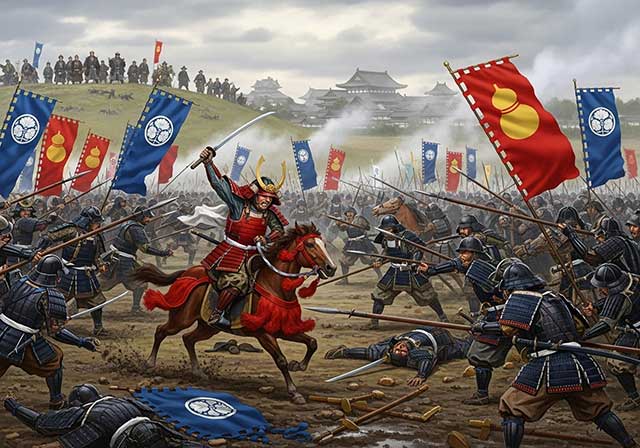
The confrontation between Tokugawa Ieyasu and Toyotomi Hideyori during the “Osaka Winter Campaign” ended with the signing of a peace treaty. On January 22, 1615, the day after the treaty was signed, Ieyasu pretended to disband his army. In reality, this meant that the Shimazu forces withdrew to the nearest port. On the same day, almost the entire Tokugawa army began filling in the outer moat.
-
Siege of Shuri Castle
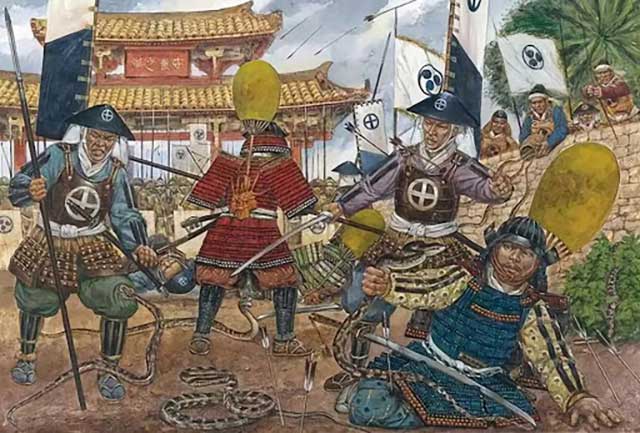
The Ryukyu Kingdom was established in 1429 on Okinawa, the largest island of the Ryukyu (Nansei) archipelago, as a result of the military unification of three rival kingdoms. In the following years, the state's control spread to all the islands of the archipelago.
-
The Siege of Fushimi Castle
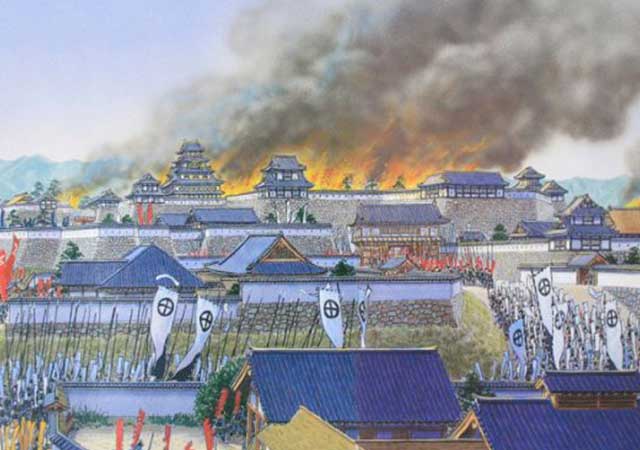
Fushimi can perhaps be considered one of the most “unfortunate” castles of the Sengoku Jidai period. The original castle was built by Toyotomi Hideyoshi in the southeast of Kyoto in 1594 as his residence in the imperial city.
-
The Siege of Otsu Castle
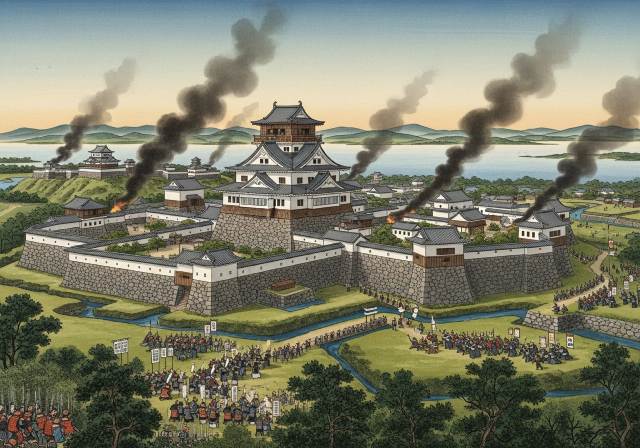
The siege of Otsu Castle was part of the Sekigahara campaign, during which the so-called Eastern Coalition, led by Tokugawa Ieyasu, fought against the Western Coalition, led by Ishida Mitsunari. Otsu Castle was built in 1586 by order of Toyotomi Hideyoshi near the capital Kyoto, on the site of the dismantled Sakamoto Castle. It belonged to the type of “water castles” — mizujō — as one side of it faced Japan's largest lake, Lake Biwa, and it was surrounded by a system of moats filled with lake water, which made the fortress resemble an island.
-
The Siege of Shiroishi Castle
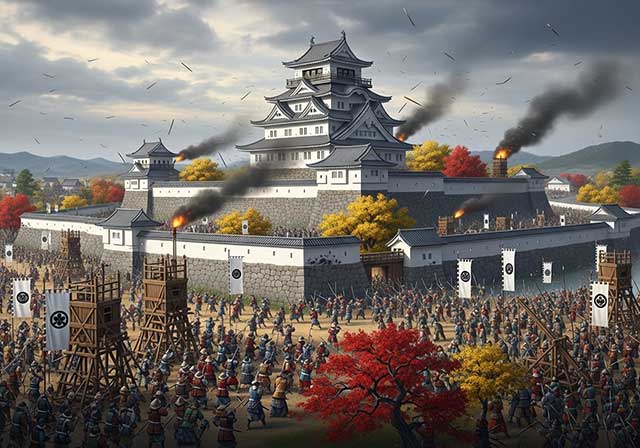
The siege of Shiroishi Castle was part of the Sekigahara campaign and took place several months before the decisive battle of Sekigahara. The daimyo of Aizu Province, Uesugi Kagekatsu, posed a serious threat to Tokugawa Ieyasu's plans to defeat the Western Coalition, and Ieyasu decided to curb his actions with the help of his northern vassals. To this end, he ordered Date Masamune to invade the province of Aizu and capture Shiroishi Castle.
-
The Second Siege of Jinju Castle
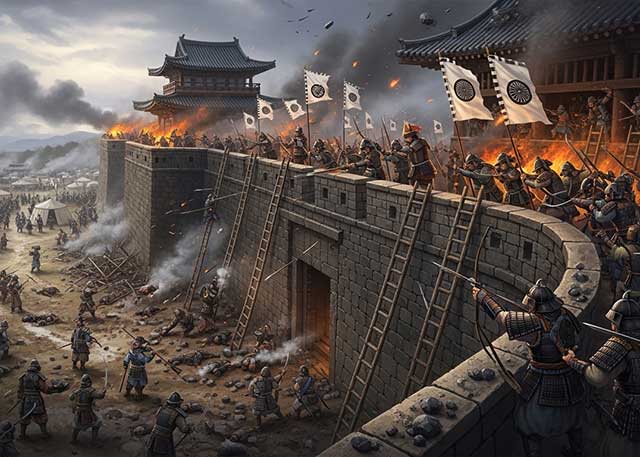
During the two Korean campaigns of the 16th century, the Japanese repeatedly had to capture enemy fortresses and defend occupied or constructed fortifications from the combined Korean and Chinese forces. Among all the operations of that time, the second siege of Jinju Castle is considered the most interesting from the point of view of siege warfare.
-
The Siege of Takamatsu Castle
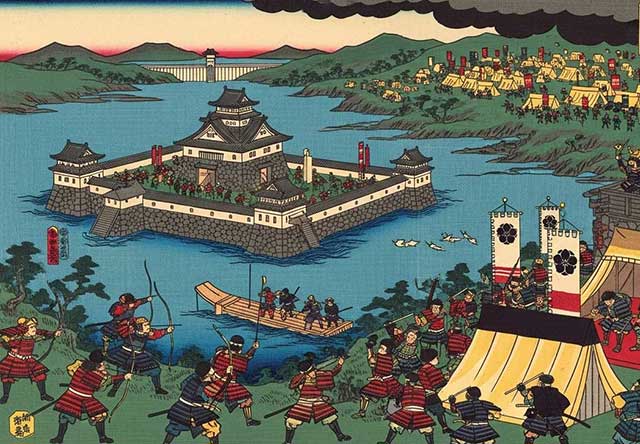
The siege of Takamatsu Castle in Bitchu Province is considered the first mizuzeme, or “water siege,” in Japanese history. Until then, such an original tactic had never been used.

